We have been starved for sun in Paris recently so when it came out at last this weekend, I had a field day!
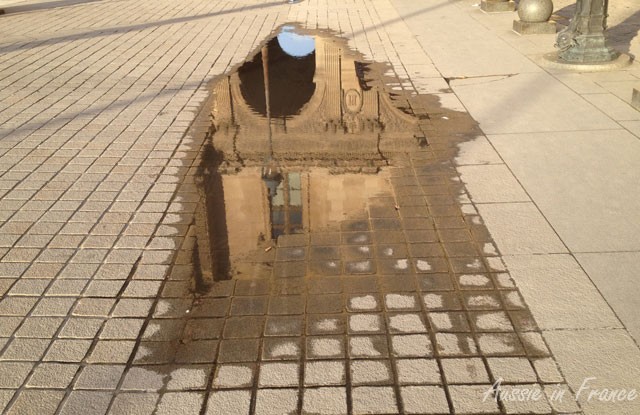
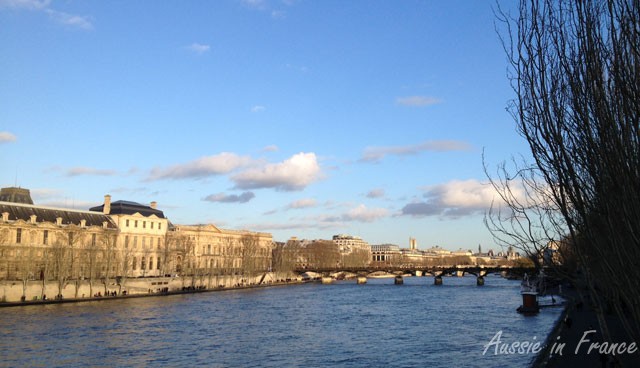

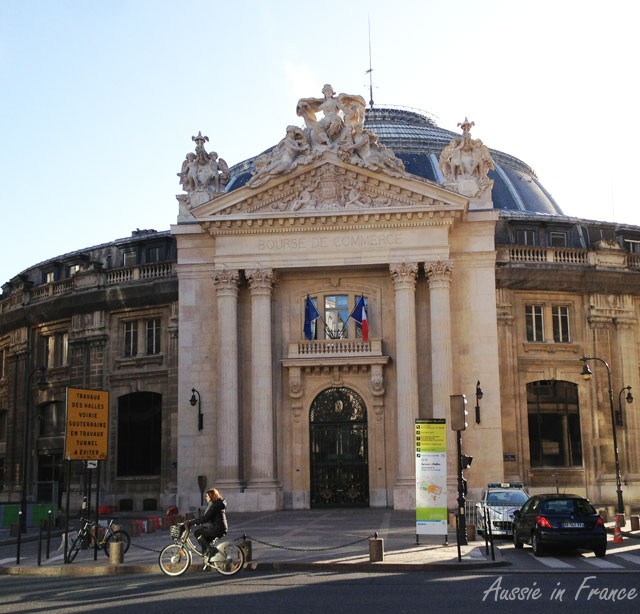
The Bourse du Commerce is beautiful inside as well!
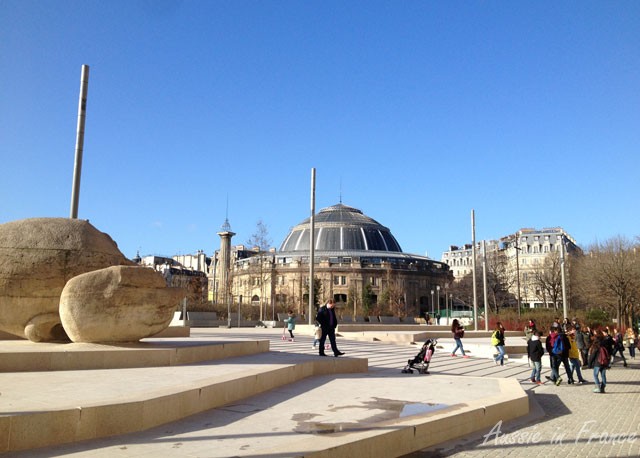
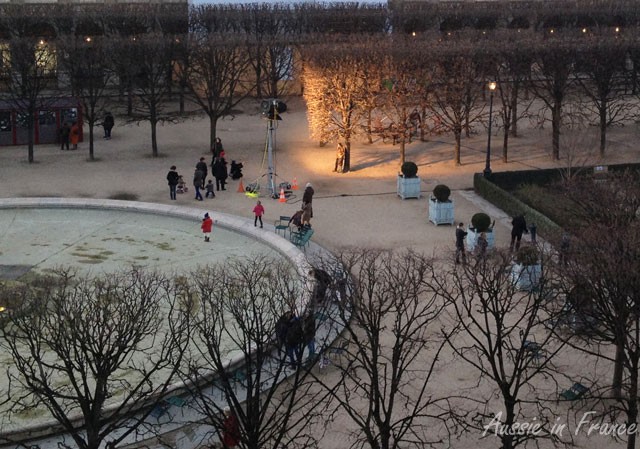
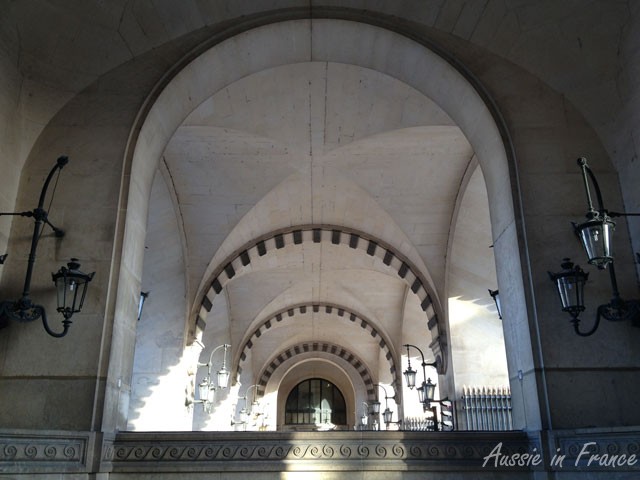
We have been starved for sun in Paris recently so when it came out at last this weekend, I had a field day!




The Bourse du Commerce is beautiful inside as well!



We went to visit Mr and Mrs Previous Owner recently and I wanted to know what they did to get rid of the moss on the front stairs. “Sur le perron“, replied Mr Previous Owner. “No, the front steps”. “Oui, le perron“, he insisted.
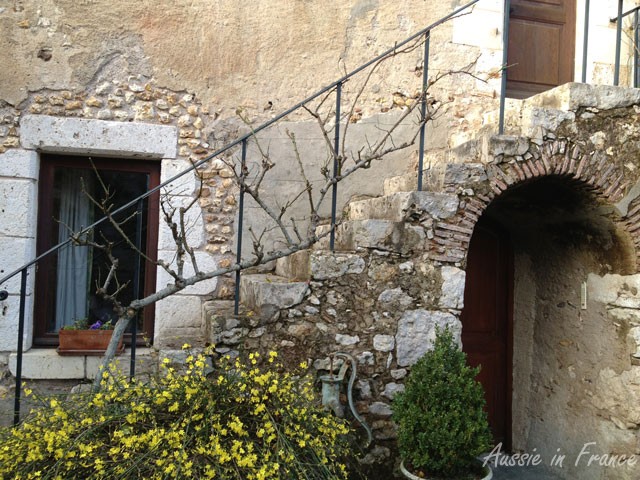
And here I had been labouring under the misconception all these years that the perron was something quite different. According to my Larousse dictionary, it is an outside staircase with a small number of steps ending in a platform leading to a front door, as can be seen in the following photo.
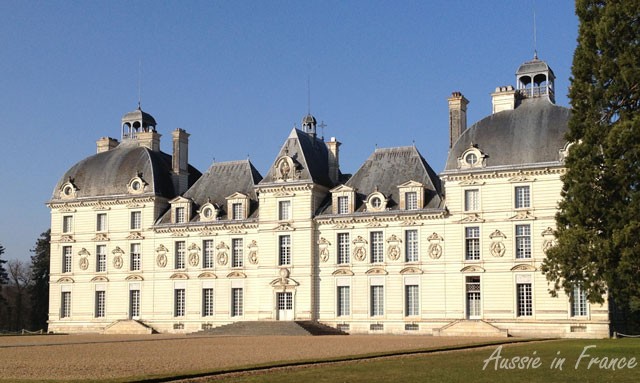
I check my Dicobat building dictionary and it doesn’t mention anything about the number of steps, so I can now talk about “notre perron”. As far as I know, we have nothing in English to describe this concept.
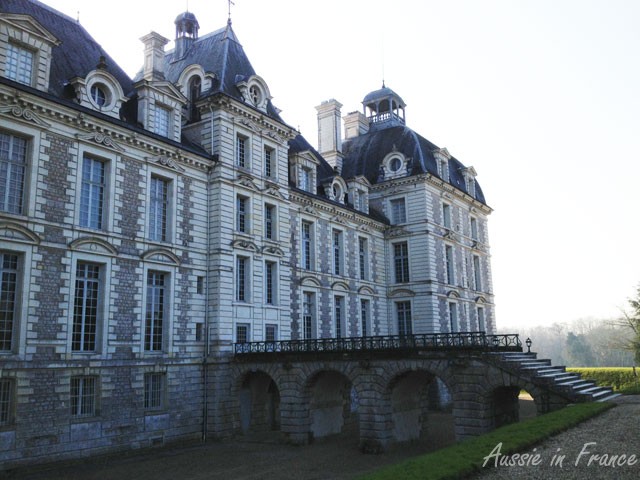
On another but slightly related subject, we’ve been looking for a solution for some time to stop treading mud into the house when it rains, particularly in winter. The area in front of the house is a combination of grass and gravel with no clear delineation.
We recently went to Truffaut to see what we could find. There was a large selection of pas japonais (pas meaning step in this context). For some reason, I thought that pas japonais were slightly staggered to the left and right to naturally follow your steps.
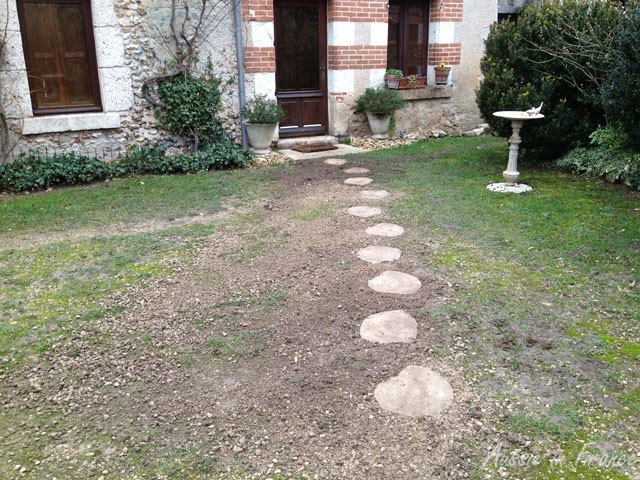
After buying the last 10 pas we liked, we laid them in light rain and I posted a photo on Facebook. “I would call them stepping stones”, said a friend. She’s right of course. I was so disappointed. We’ve ordered some more for the rest of the garden but I can see we’ll have to lay the other ones again. It’s so annoying trying to remember whether you should be starting with your left leg or your right leg. Sigh.
Welcome to this week’s Blogger Round-Up. Three posts caught my eye immediately this week. The first, by Janine Marsh from The Good Life France, tells the story of an Australian couple who have bought a château in the south of France to renovate. It is a stunning project and I wish them luck and the finance to carry it through! Liz from Young Adventuress lures us to the less-known south of Italy, starting with Positano on the Amalfi Coast and ending with Matera. And I couldn’t resist the write-up on this year’s no-pants subway event by Mary Kay from Out and About in Paris. Enjoy!
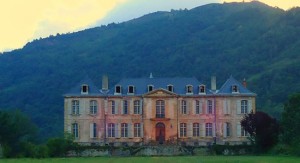 How many of us dream of owning and renovating a French chateau? A palace that was lived in by French aristocrats, where the rich, powerful and famous partied and where every room reveals a story from the past?
How many of us dream of owning and renovating a French chateau? A palace that was lived in by French aristocrats, where the rich, powerful and famous partied and where every room reveals a story from the past?
Karina Waters is from Perth, Western Australia where, in what “feels like a previous life now” she worked in corporate and tax accounting and lived with her husband Craig, a surgeon and their two children. In 2011 Karina and Craig decided to buy a home in France. They had lots of French friends who on their first viewing trip in the region of the Dordogne did their best to come up with ideas for “what would suit an Australian family”. Karina and Craig spent a week looking at the houses their friends had chosen. Karina says they were all “renovated, clean and neat, ticking the box for a quiet life”. She returned to Perth “frankly disappointed”, her ideal home would be more “shabby chic, rustic, petit chateau style” and she hadn’t seen anything that came even near that description. Read more
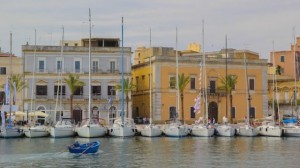 Maybe I’m wrong (please tell me if I am) but after spending some time in southern Italy, I’ve realized a few things, the first and foremost being that it doesn’t get the attention it deserves. Rome, Florence, Venice, and all those great cities and regions of the north get heaps of love from us foreigners, and for good reason, they rock. But what about the south? Read more
Maybe I’m wrong (please tell me if I am) but after spending some time in southern Italy, I’ve realized a few things, the first and foremost being that it doesn’t get the attention it deserves. Rome, Florence, Venice, and all those great cities and regions of the north get heaps of love from us foreigners, and for good reason, they rock. But what about the south? Read more
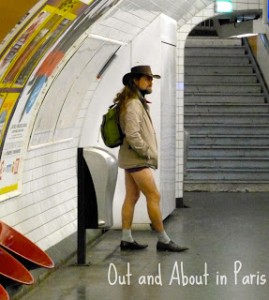 Metro line 1 is notorious for pickpockets. Every couple of stops, there’s a public announcement in at least four different languages warning passengers to keep a close eye on their belongings. If you happened to be riding the metro from Charles de Gaulle – Étoile in the direction of Bastille at approximately 3:45 pm yesterday, it might have occurred to you that the pickpockets had been busy stealing more than just wallets. In honor of the third annual No Pants Subway Ride in Paris, many of the passengers were traveling trouserless. While participants without bottoms read newspapers, studied route maps or nonchalantly chatted on cell phones, astonished passengers tried their best not to stare at all the exposed limbs in the middle of winter. Read more
Metro line 1 is notorious for pickpockets. Every couple of stops, there’s a public announcement in at least four different languages warning passengers to keep a close eye on their belongings. If you happened to be riding the metro from Charles de Gaulle – Étoile in the direction of Bastille at approximately 3:45 pm yesterday, it might have occurred to you that the pickpockets had been busy stealing more than just wallets. In honor of the third annual No Pants Subway Ride in Paris, many of the passengers were traveling trouserless. While participants without bottoms read newspapers, studied route maps or nonchalantly chatted on cell phones, astonished passengers tried their best not to stare at all the exposed limbs in the middle of winter. Read more
We kept on passing Château de Beauregard when cycling to Chambord and Cheverny, so we finally scheduled a visit on a Sunday morning in March. We were surprised to run into friends from Montrichard who had just finished their visit! It’s a small world, isn’t it?
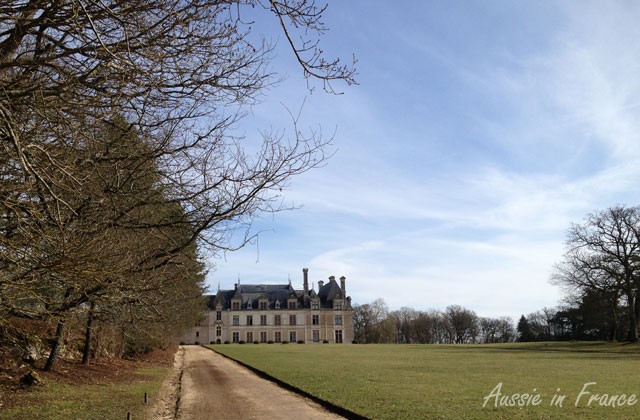
The château started off as a manor house in the 15th century and was confiscated from the owner, François Doulcet, by Louis XII when he was found guilty of embezzlement. François I used the house as a hunting lodge before giving it to his uncle René de Savoie who sold it to Jean du Thier, Henri II’s finance minister in 1545. Work carried out between 1553 and 1559 turned Beauregard into one of the finest châteaux in the Loire Valley. A gallery and an L-shaped wing were added to the original building.
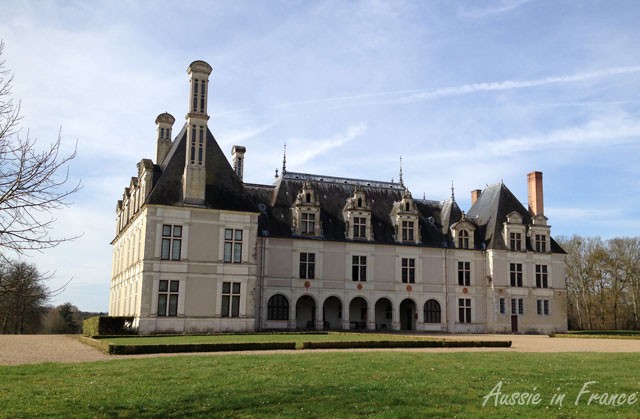
The harmonious Italianised architecture includes arcades in the gallery surmounted by terracotta medallions. Its high white chimneys “à la Chambord” are incrusted with slate. All that remains of Jean du Thier’s interior decoration, however, is the Cabinet des Grelots, his work cabinet, with its delicately sculpted caisson ceiling completed in 1554 by the royal cabinetmaker Scibec de Carpi. The name grelot is derived from Jean du Thier’s coat of arms: 3 gold bells (grelots) on a blue background.
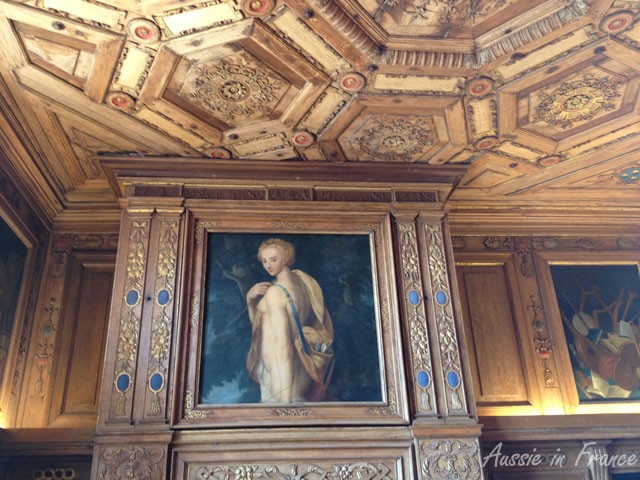
But it was Paul Ardier, Louis XIII’s minister who was responsible for its most prominent feature. After retiring from political life, he decorated the Grand Gallery between 1620 and 1638 with 327 portraits spanning three centuries (1328 to 1643), forming the largest collection of historical portraits in Europe. They are not all works of art, of course, but the collection is impressive.
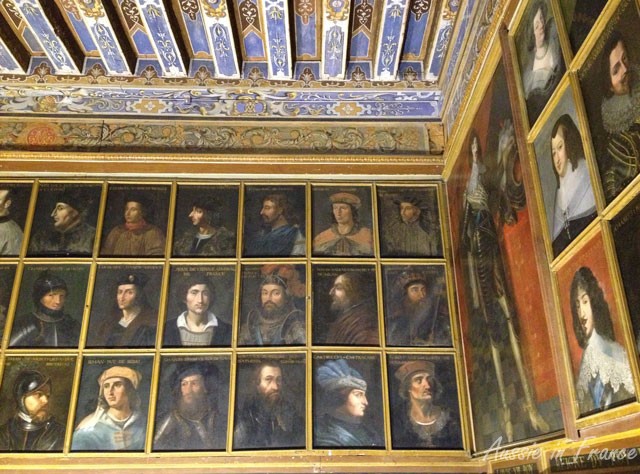
Ardier’s son and granddaughter added the Delft floor tiles, lapis lazuli ceiling and sculpted murals. The Ardier family left the château in 1816.
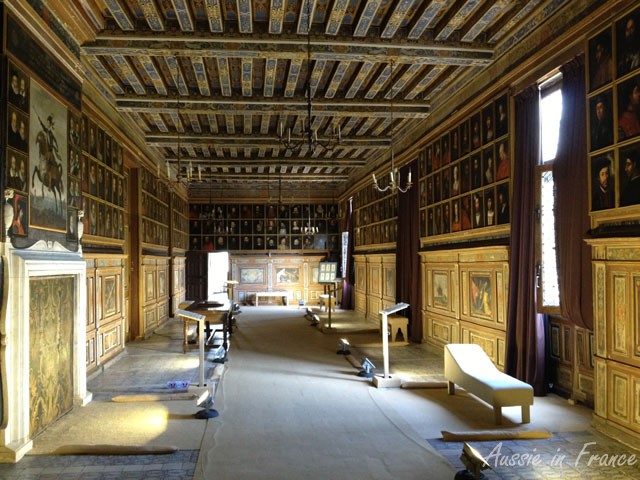
The west wing was destroyed in the 19th century and a second gallery built on the south side. It was modernised in the 20th century by the Tillier family before being bought by the Pavillon family in 1925. It was opened to the public in 1957. Restauration is ongoing and the landscaped park has now been completely restored.
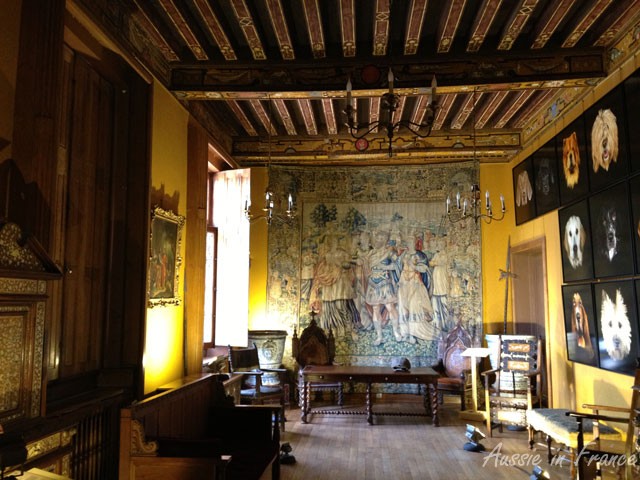
The château also houses a portrait exhibition of dogs owned by famous people. The International Animal Portrait festival was launched in 2012.
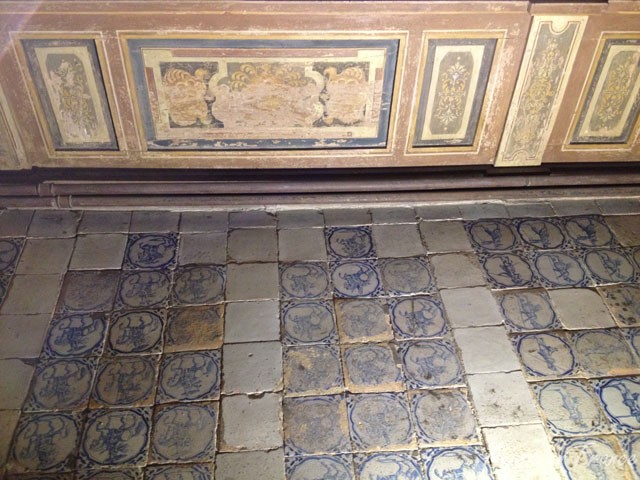
We did not explore the grounds which are obviously not their best in mid March. The Cabinet des Grelots and the Portrait Gallery in particular are quite exceptional but the other rooms are somewhat disappointing.
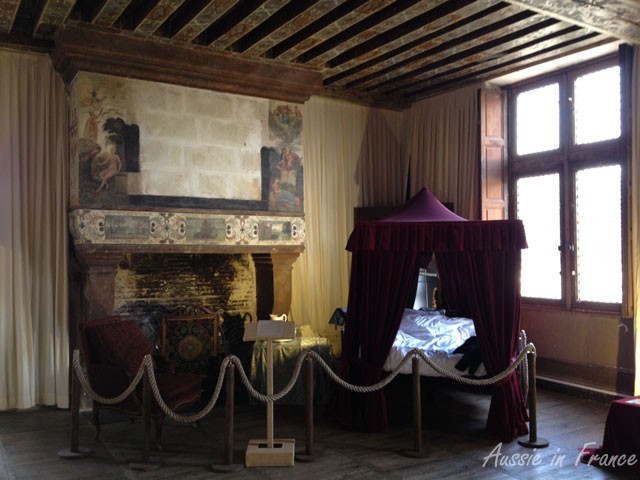
Some effort has been made to recreate the atmosphere in one of the bedrooms but I’m afraid it’s not very convincing. Dog lovers, however, will no doubt appreciate the exhibition, even if it seems a little incongruous.
Opening hours 18th November to 14th February, by reservation only (groups). 15th February to 30th March 11 am to 5 pm, 31st March to 29th June, 10 am to 6 pm, 30th June to 31st August, 10 am to 7 pm, 1st September to 2nd November, 10 am to 6 pm, 3rd November to 11th November, 11 am to 5 pm. Restaurant open from 10.30 am to 6 pm from 1st to 29th May, July and August. Prices Park and château : 12.50 euro (park only : 9 euro); children from 5 to 13 : 10 euro (park only : 9 euro)The history of Plovdiv, Bulgaria’s second largest city after Sofia, spans 6,000 years and includes periods of Thracian, Greek, Roman, Byzantine and Ottoman occupation, all of which can be seen in its attractive architecture. The old town has been extensively renovated with many painted façades, particularly from the Bulgarian Revival period in the 19th century. Here are just a few examples.

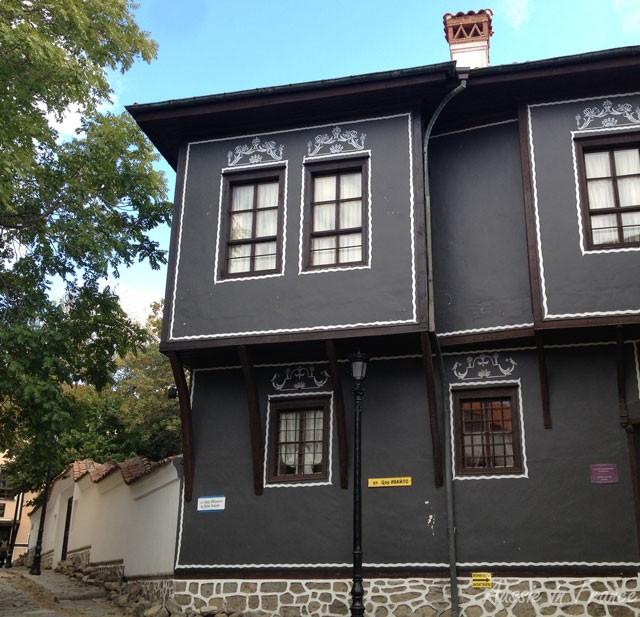
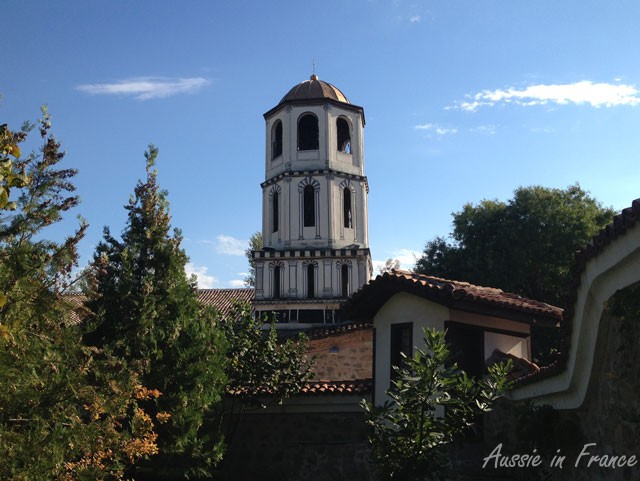
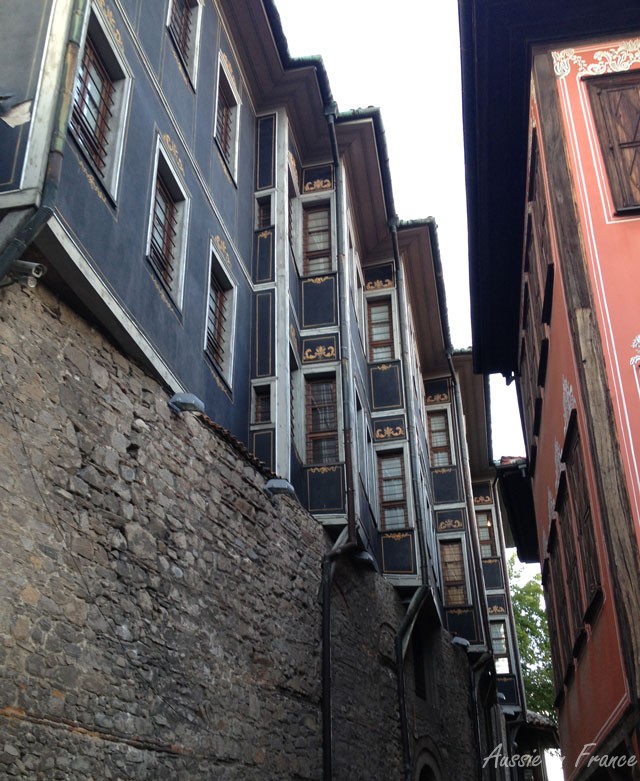
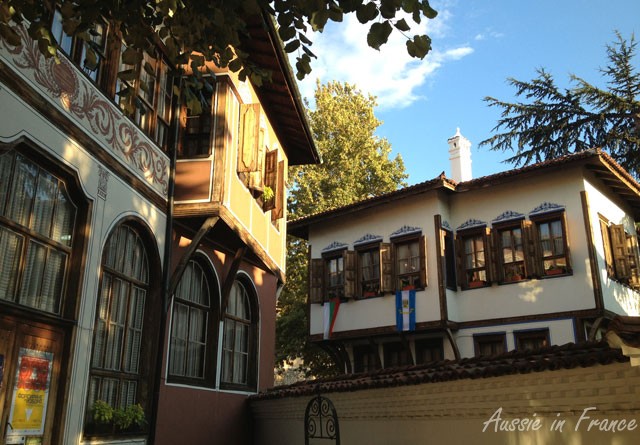
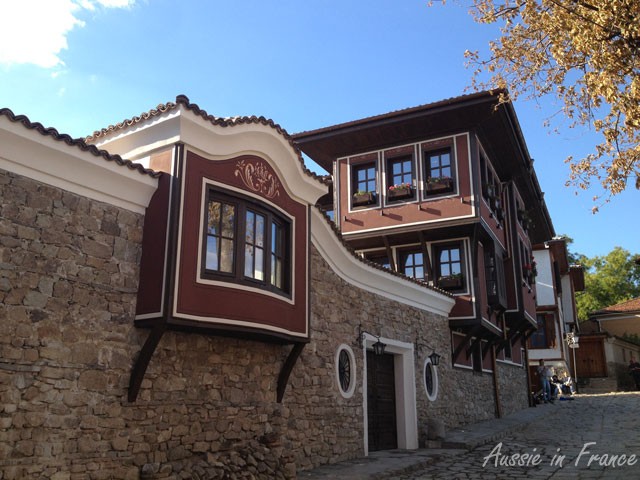
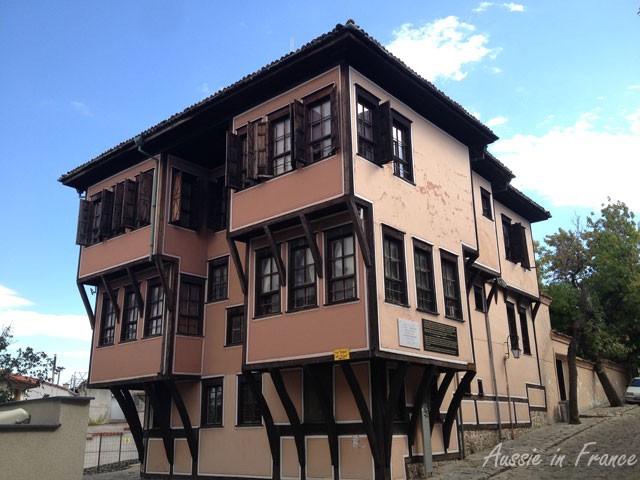
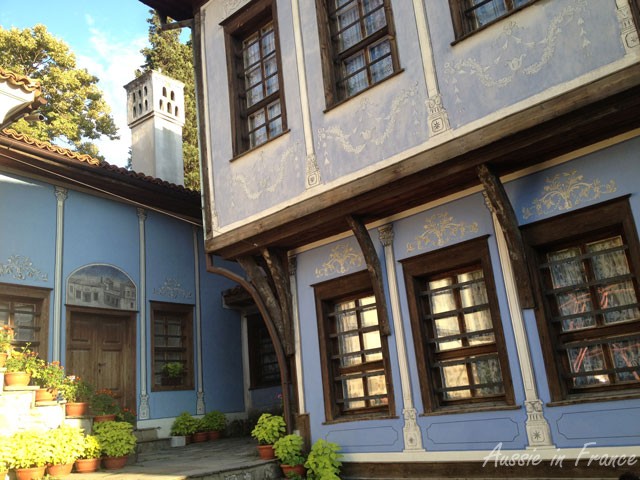
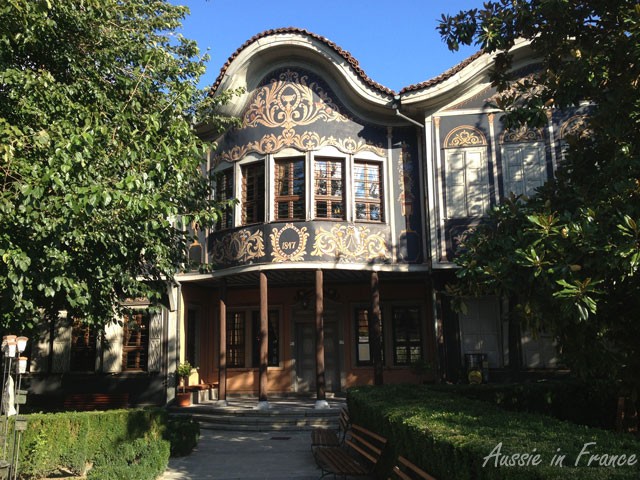
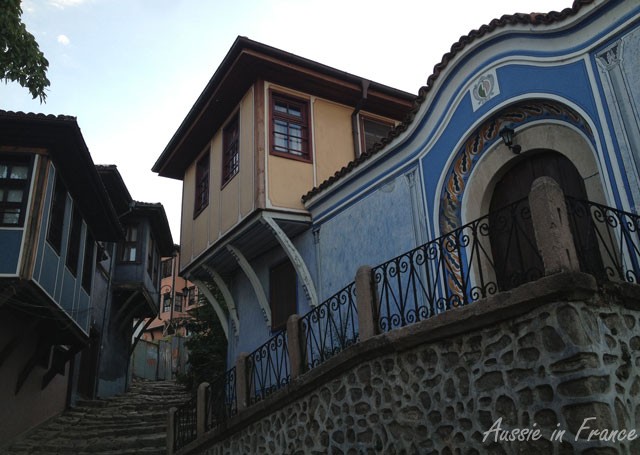
We leave our home exchange apartment in Sofia around 10 am. It’s a short walk to the central bus station. We go past a group of bystanders and see three men lying on their sides on the ground, hands handcuffed behind them and surrounded by police officers in front of a police station. I’m not brave enough to take a photo unfortunately. It’s the first sign of crime we’ve seen since we arrived.
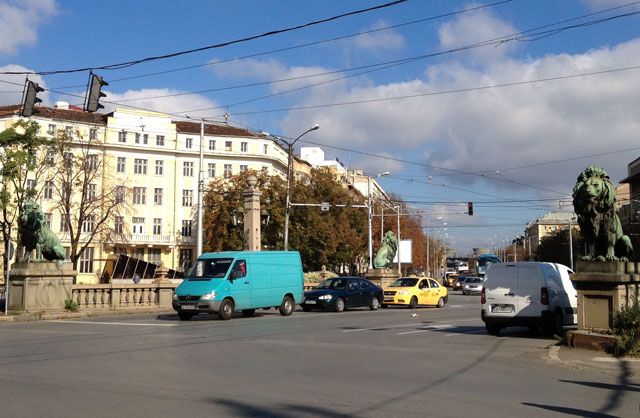
Our walk takes us past the Lion Bridge and along the first bike path we’ve seen too. It’s a very good bike path, much frequented by pedestrians and perfect for our roll-on bag. We only see one bike. We arrive at the very modern bus station. I buy the tickets (14 lev each) from a window on the right as you walk in and am served by the rudest person you could imagine. That, too, is a first in Bulgaria.
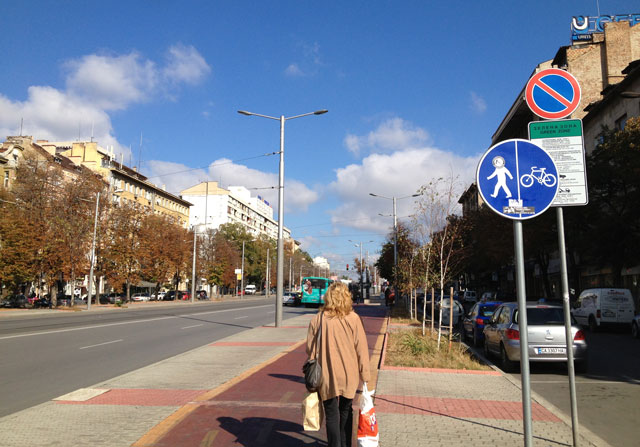
I go to the Ladies (0.5 lev) and we make our way to platform 6 to take the 11 am bus. The buses leave every hour on the hour. We climb in and I am surprised to see there is no one down the back. We take the first two available seats together. The bus fills up and a very big, loud woman arrives and is obviously saying I’m in her seat. She shows us her ticket and we discover, to our surprise, that ours are numbered too! The lady behind us says to stay put and says something to the other lady who goes off to find another seat. We’re relieved because our seat numbers are not together!
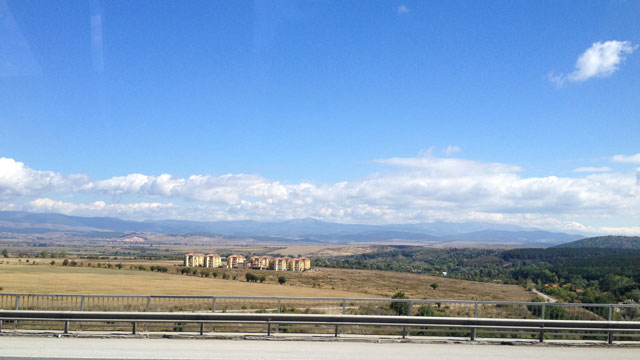
The trip itself, mainly along the motorway, is fairly monotonous and takes a little over 2 hours. When we get out, it already feels different from Sofia. The sun is shining and it’s a bit warmer. We find Yvan Vazov street and start walking the 15 minutes to our hotel. I immediately feel good in Plovdiv. The street is lovely and shady and there is a definite vibrancy in the air. It is less run-down than Sofia.
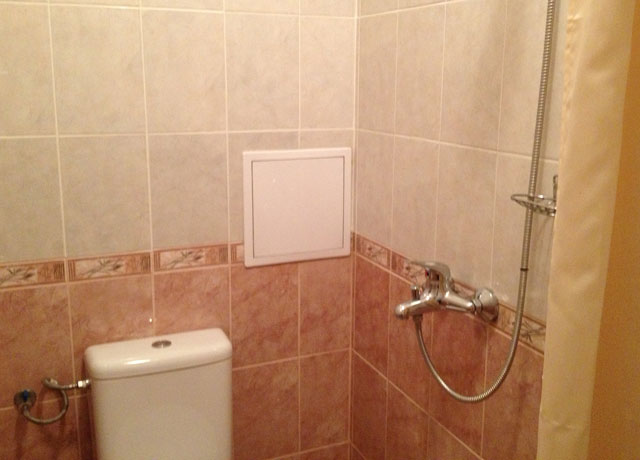
We arrive at the Romantica Hotel and the friendly receptionist takes us to our room. It was the last one available when I booked several days earlier and although there are twin beds, I was told they could be pushed together. Considering the size of the room, right next to reception, I might add, there isn’t much hope of that. But the real surprise is the bathroom. The toilet is IN the shower area with a curtain in front of the toilet. I’ve never seen that one before! Definitely not as romantic as its name.

I like the look of the restaurant opposite, which is called Hemingway, so we decide to eat there. Our initial plan to sit on the very attractive terrace is thwarted by construction work just next to our hotel. Oh dear, I hope it doesn’t start too early in the morning.
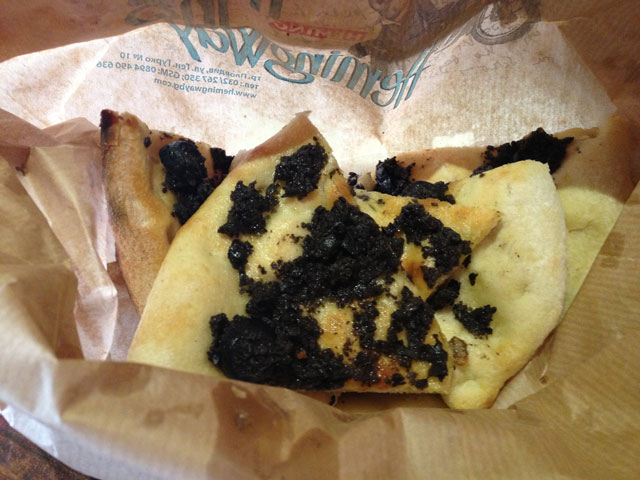
When the waiter hears us speak French, he goes off to get another waiter who speaks excellent English (learnt from the movies) and a smattering of French. We order a couple of delicious vegetarian dishes and a glass of excellent wine. I choose some divine foccacia-like bread served in a paper bag. It’s the best meal we’ve had in Bulgaria so far, all for a mere 30 lev (15 euro) for the two of us. I’m liking Plovdiv more and more.
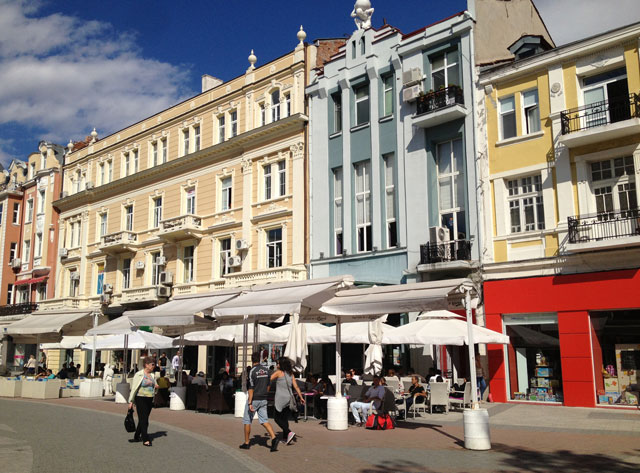
After lunch, we set off for the old town. But that will be another post!
Hemingway, 10 Gurko Street, Plovdiv. 9 am to 1 am. Tel 032 267350. Mobile 0894490636. http://hemingway.bg/en. office@hemingwaybg.net
You’ve probably never even heard of Saint Eustache, although you may have seen it if you’ve been to the famous market street of Montorgueil behind the old central markets or halles which are under renovation at the moment and not exactly a tourist attraction.
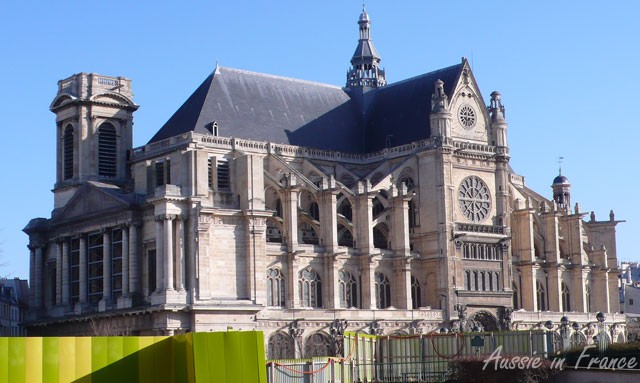
The church is very ornate, in the gothic style of Notre Dame. Like many cathedrals, it took over a hundred years to build – from 1532 to 1640 – and is located on the site of a chapel dedicated to Saint Agnès. The plan is gothic but the decoration is renaissance. Over 33 metres high, 100 metres long and 43 metres wide, it is very imposing despite its missing tower.
So how do we tell the difference between gothic and renaissance? Gothic architecture originated in France in the 12th century and its most famous example is Notre Dame. Its characteristic features are the flying buttress, the ribbed vault and the pointed arch.
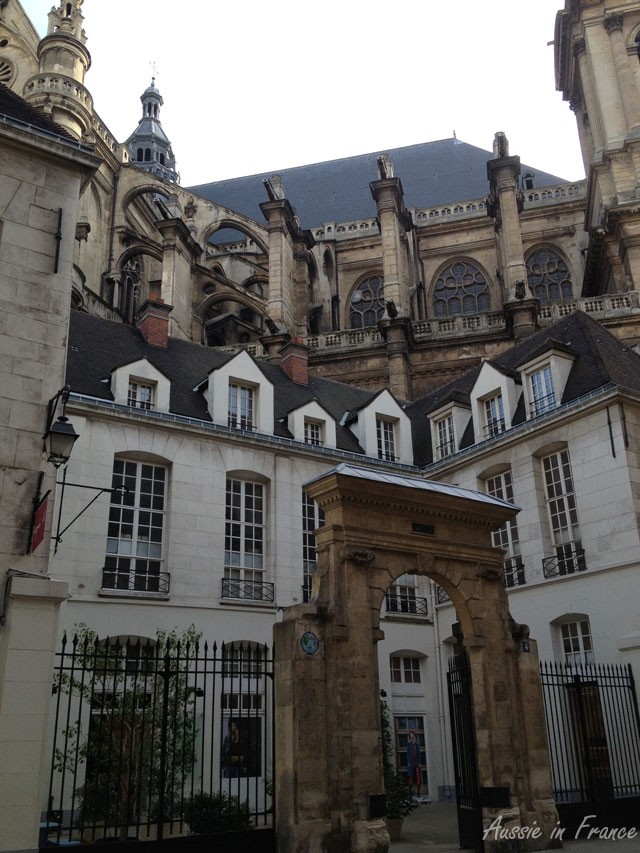
It was the flying buttress that enabled architects to build increasingly higher churches because the buttress takes the extra weight off the load-bearing walls. Churches in the previous period – Romanesque or roman in French were much smaller and had no buttresses. They are more prevalent in the south of France.
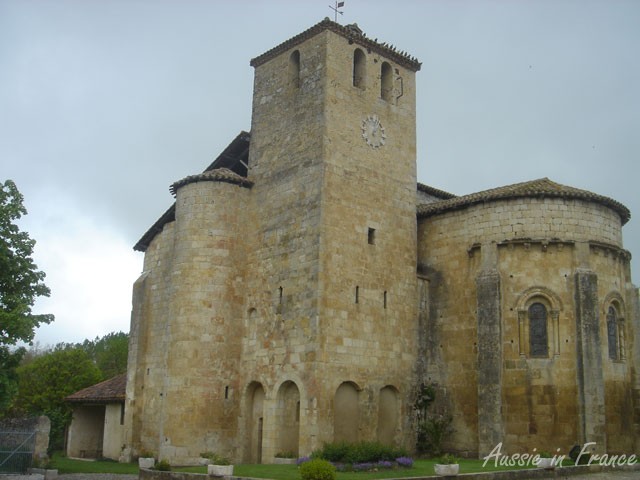
Along with the ribbed vault, the flying buttress meant that more windows could be added high up in the building. When ribbed vaulting is used, the arching and intersecting stone ribs support a vaulted ceiling surface made of thin stone panels, which greatly reduces the weight of the ceiling vault.
The pointed or ogival arch may be of Islamic origin or have evolved naturally in Western Europe as a structural solution to a purely technical problem but whatever the case, it ‘s a distinguishing feature of Gothic architecture.
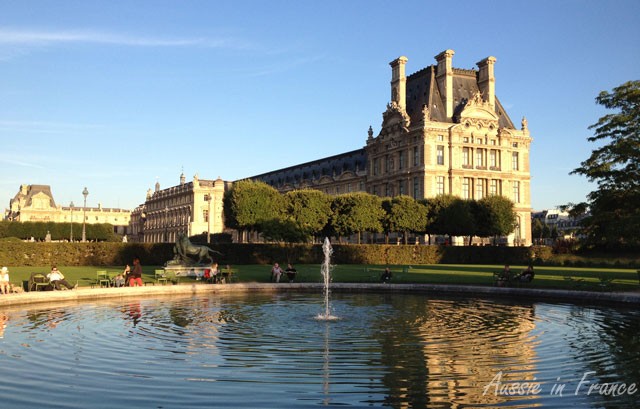
Renaissance is the next period after that, between the early 15th and early 17th centuries. It originated in Italy but soon spread across Europe. It puts emphasis on symmetry, proportion and geometry and features orderly arrangements of columns, pilaster and lintels, with semicircular arches, hemispherical domes, niches and edicules. The Louvre is a prime example of Renaissance architecture.
The buttresses on Saint Eustache are not as obvious as those of Notre Dame, for example, and the western façade, with its classical lines, is perfectly symmetrical except for the missing tower.
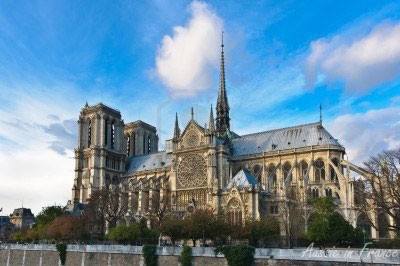
If you go around the back of Saint Eustache, you’ll see a small plaque dated 1213 with a fish trying to bite its tail, a reminder that a man once made his fortune from the local fish markets. On Sundays, our fishmonger’s stall is coincidentally just in front of it!
Jean Allais, a Parisian bourgeois, helped to finance Philippe Auguste’s crusades and in return, he asked to be allowed to levy a tax of one denier for each basket of fish sold in the covered market (or Halle whence the current name of the area).

He made a fortune and felt such remorse ( !!!) that he built a chapel for the fishmongers dedicated to Saint Agnès. It was added to over the centuries, partly demolished, and rechristened Saint Eustache. It was finally razed to the ground in the 16th century and the present church built and never completed.
A crypt in the basement of the church still bears the name of Saint Agnès. Remains of the original chapel can still be seen. Access is via a small door, but only during temporary exhibitions and concerts.
Which is your favourite Gothic church?
We’re debating about a day trip from Sofia to Rila Monastery because it’s a 2 to 2 ½ hour bus trip each way (120 K) but various friends have encouraged us to go and the photos are certainly encouraging. It’s also a World Heritage site. We also want to go to Boyana Church in the suburbs of Sofia. After a search on the Internet I find a company called Traventuria offering a day trip including both destinations for 25 euro per person, which is an attractive price. I check out Trip Advisor and the fact that the coach drivers are reputed to be careful cinches it for me.
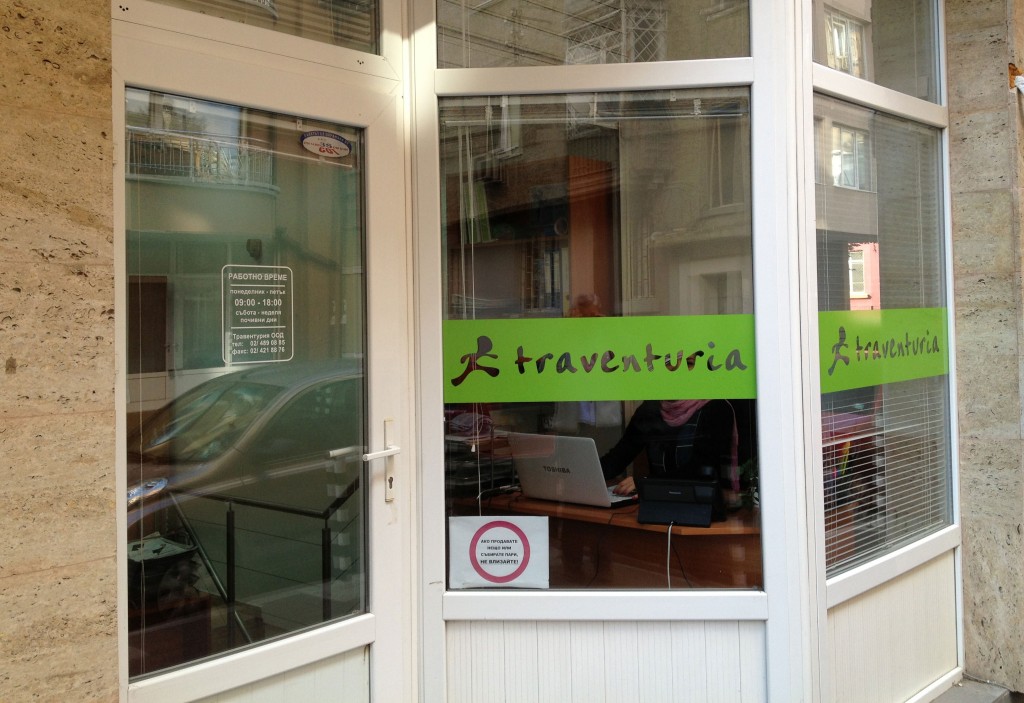
As I start booking, I notice the address at the bottom of the screen. Unbelievably, it’s the same address as ours – their office is on the ground floor of our home exchange building in Veslets Street. We decide to go and pay in cash next morning. The girl is very friendly, speaks excellent English and even gives us an aluminium water bottle each.
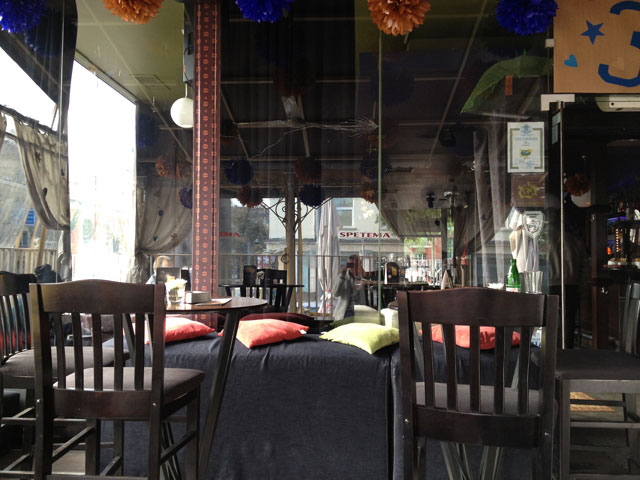
We set off at 8.15 to be well in time for our 9 am rendez-vous behind Nevski Cathedral. Sofia is quite different at that hour, we discover, with everyone hurrying to work. We have time for a coffee at a trendy bar called Spetema just opposite the university.
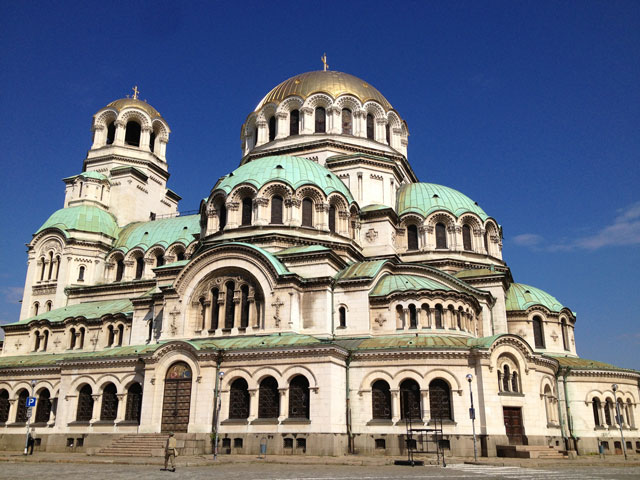
Our 12-seater mini-bus pulls up on time but we wait for a couple of people who never come and finally move off at 9.15 am. There are eight of us altogether. Our young guide tells us the programme: a two-hour drive with a ten-minute rest-stop on the way, two hours at Rila, then back towards Sofia and Boyana where we stop for half an hour. We’ll be back in Sofia by 5 pm.
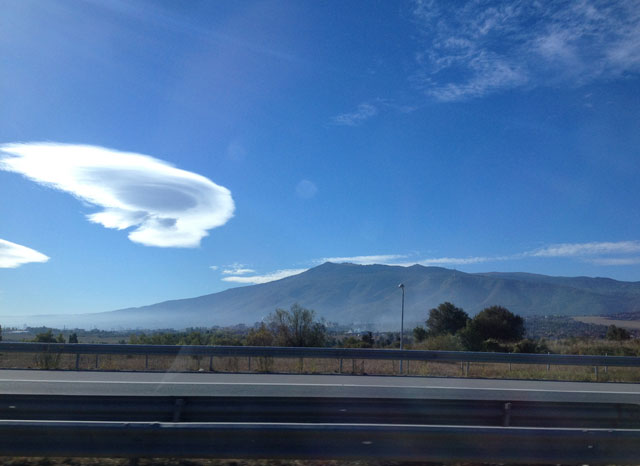
We’re soon on a recent 4-lane highway going at a reasonable pace. I’m reassured. The countryside looks surprisingly like Australia, minus the gum trees. There is little agriculture and only a few weedy looking cows. The cloud formation is quite unique. Jean Michel says there must be a lot of wind. The sky is a deep blue.
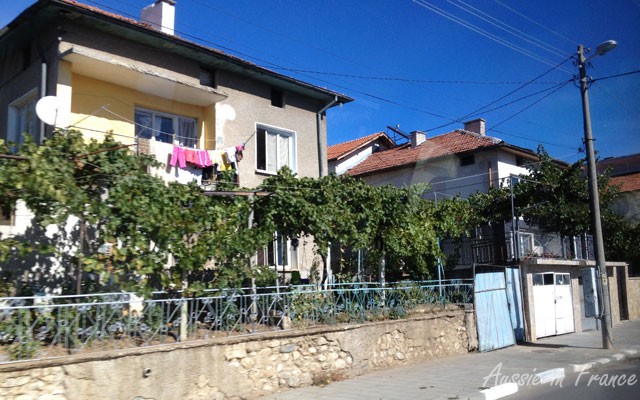
After our rest-stop, we soon turn left and begin circumnavigating Rila Mountain, before making the ascent. I’m amazed at how many houses in the villages have grape vines. The monastery is 1147 metres above ground level (the highest peak on Rila is 2925 metres). We go through mountain forest most of the time. The driver is going quite slowly and I’m not afraid.
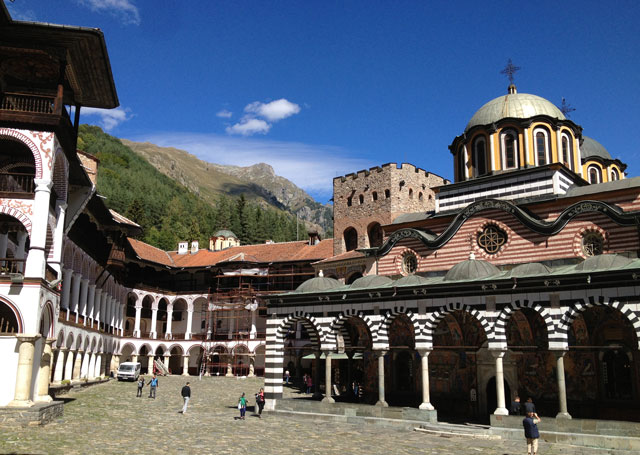
At the top, he pulls up and we get out. The initial impression is quite fabulous and we are not disappointed with the rest of our visit. We expected more people, but are pleasantly surprised to see that if we wait long enough, we can take photos without tourists in brightly coloured clothing taking photos of each other.
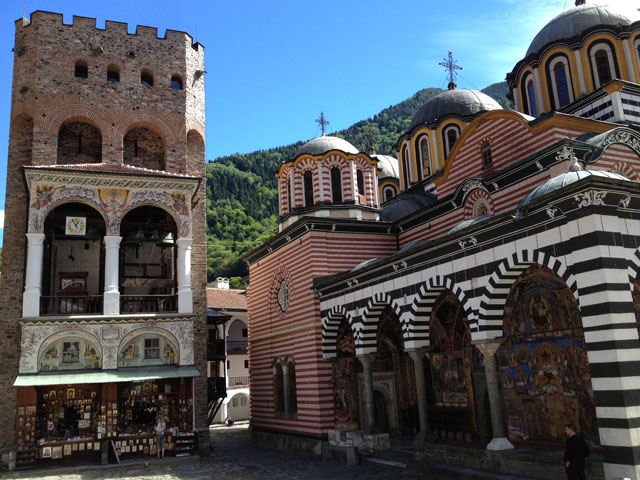
Jean Michel finds a booklet in French and we track down all the things to see because it’s a bit tedious to translate my audio-guide. Rila was founded in the 10th century by the hermit St John of Rila. It was destroyed by fire in the 19th century and rebuilt between 1834 and 1862 and is a characteristic example of the Bulgarian Renaissance (18th-19th centuries), symbolising the awareness of a Slavic cultural identity following centuries of occupation.
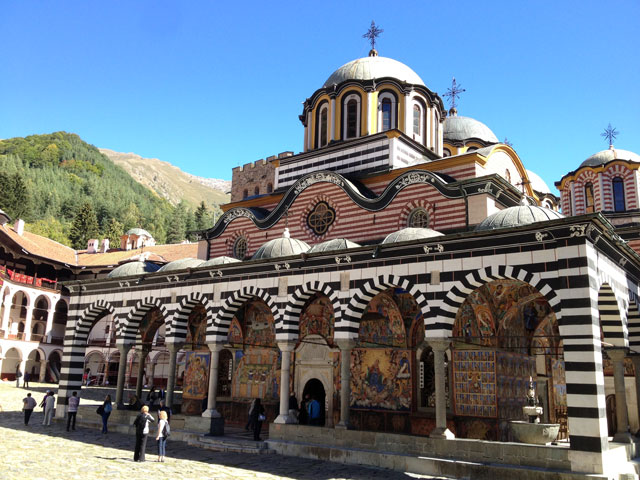
At the end of our visit, there are still three things on the list we haven’t seen, one in the koprivchtitsa room, one in the priory and the other in the tower chapel. We ask in the religious shop and are told to inquire at the museum which we have already visited and contains the most fabulous carved cross I’ve ever seen (81 x 43 cm) by a monk called Rafail, with 104 religious scenes and 650 miniature figures and 12 years in the making. Hardly surprising that Rafail lost his sight in the process. No photographs allowed however.
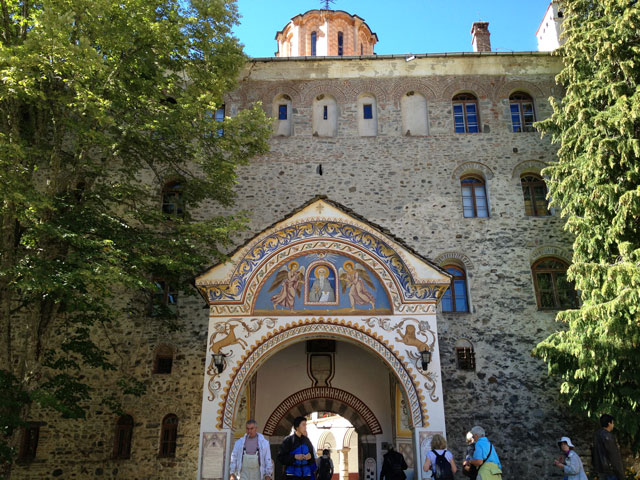
First, we are told no, then the lady at the cash desk picks up her phone, puts it down again and says “30 minutes”. By that time our mini-bus will have left. Disappointed we didn’t ask earlier, we go and wait for our bus which soon appears.
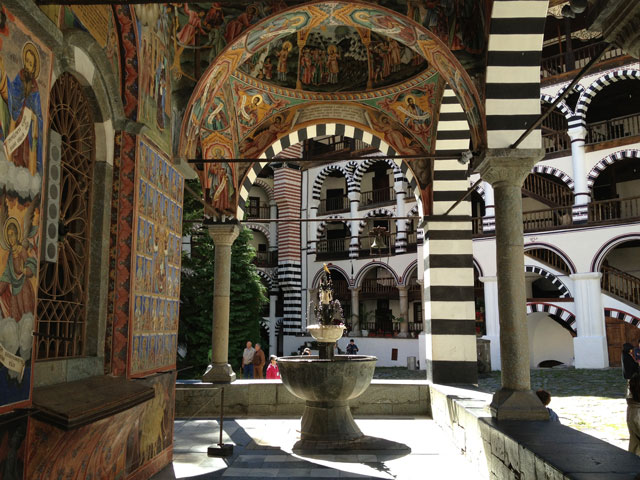
One and a half hours later, our guide tells us we are nearing Boyana Church and that two large coach-loads are expected. If we want to get in before them (only 12 people are allowed in the church at a time for a maximum of 15 minutes), we have to hurry. He collects our entrance fee (10 lev per person) and when we arrive, he buys our tickets and takes us down to the little church.
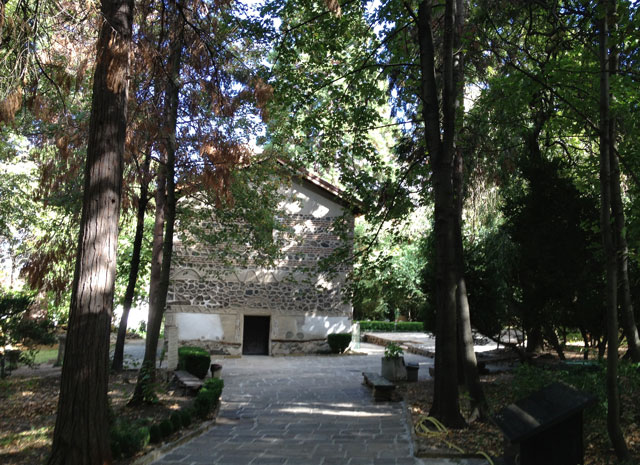
There are three churches, each joining onto the other, built in the 10th to 11th, 13th and early 19th centuries. The frescoes are all from the 14th century. To quote a UNESCO review of this World Heritage site, those painted in 1259 “possess a rare freedom, realism, harmony in the proportions, liveliness and warmth that already foresaw the birth of the Italian Renaissance. The site is one of the most complete and perfectly preserved monuments of east European mediaeval art.”
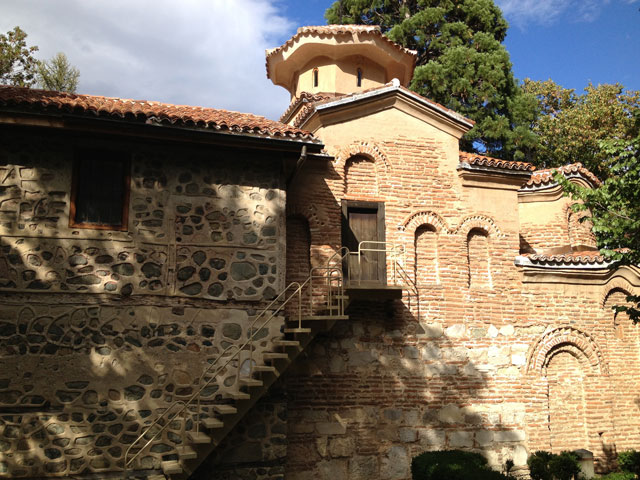
The faces are extremely expressive and the figures include Sebastocrator Kaloyan and his wife Desislava who commissioned the 13th century extension and the frescoes. Our party didn’t choose a guided visit, but I definitely recommend you to do so. As usual, photos of the interior were not allowed, but the website Pravoslavieto has excellent illustrations and descriptions.
This is definitely our best day in Bulgaria so far.
Traventuria Ltd., 45 Veslets Str., 1202 Sofia, BULGARIA, 0035924890884 (Monday – Friday, 08:30 – 16:30 CET), Fax: 0035924917352, www.traventuria.com, info@traventuria.com If you have enjoyed reading this, don’t forget to subscribe to new posts using the subscription form on the top right – that way you’ll get them directly on your smart phone or in your mail box! And I love to hear your comments!The sky is a stunning blue although the temperatures have dropped a little. We go directly to the imposing church of St Nedelya, just across from the statue of Sofia and the little church of St Petka, with the School of Theology in the background. As we approach it, we see a lot of activity under white tents. It turns out to be a book fair. We notice there are very few book stores but lots of book markets.
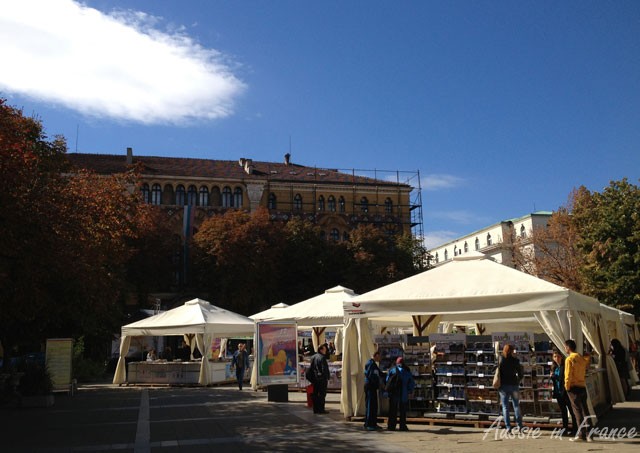
St Nedelya, or Holy Sunday, is a mediaeval Eastern Orthodox Church that has been destroyed and reconstructed many times throughout the ages. It was razed in an assault in 1925 that claimed over 150 victims. The tzar, Boris III, who should have been the main victim, escaped because he turned up late, a typical Bulgarian trait so I am told later by a Bulgarian. It was restored between 1927 and its inauguration in 1933. What a chequered existence!
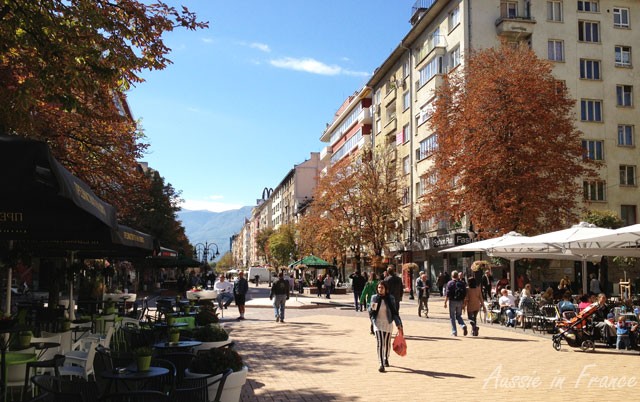
If you look straight ahead as you come out the church, you will see Vitosha mountain in the distance. Vitosha Boulevard is Sofia’s most expensive shopping street. The population is dressed very differently and there are lots of French and other foreign stores but they are hardly big names: Adidas, Promod, Le Coq Sportif, etc.

What we like are all the sidewalk cafés with the mountain as a backdrop, though they are twice the price of the others we’ve been to, but still much cheaper than Paris. We pay 4 lev for 2 espressos at Vitosha Street Café. We take a look at the local paper and I see a report on yesterday’s festivities but unfortunately I can’t read it.
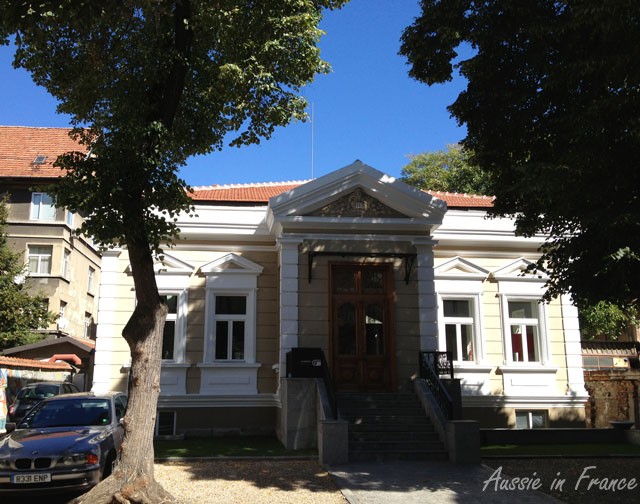
We then head in the direction of Eagles’ Bridge, wandering through a much more upmarket area than our own neighbourhood. Ultra-modern buildings juxtapose renovated 19th century mansions.
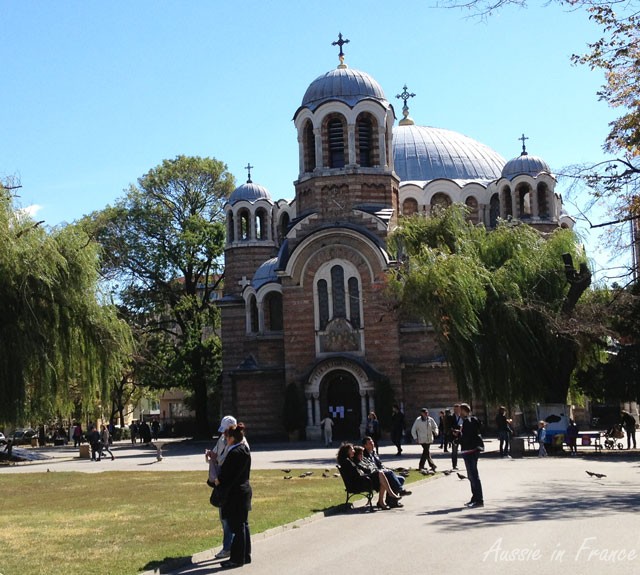
Yet another church, Sveti Sedmochislenitsi, and another market appear as we get closer to the university where we intend to find a sunny bench in a nearby park to have lunch (it’s an intermittent fast day for us) because the weather has become surprisingly chilly.
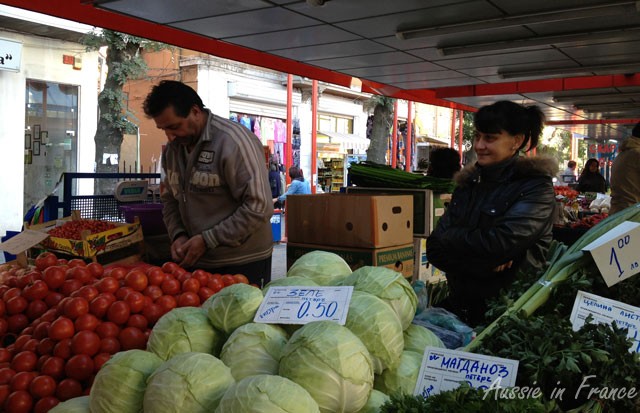
We’ve been back to the Ladies’ market to buy the day’s vegetables – 4 tomatoes, 1 eggplant, 1 zucchini, 1 capsicum, 1 cucumber and a couple of handfuls of green beans, all for an amazing 2 lev. White and black grapes are 1.20 lev a kilo. That’s about 60 euro cents.

Jean Michel stops to admire the external wiring on some of the houses.
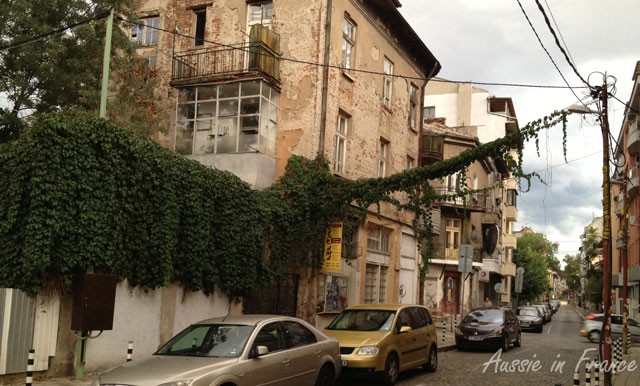
Not nearly as good as the ivy-covered cables I saw last night on our way to dinner though!
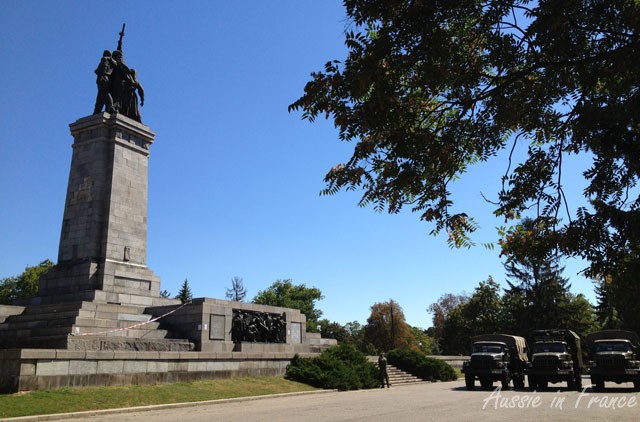
We sit next to the Soviet Army monument and are surprised to see several army vehicles on one side and canons on the other. I learn afterwards that the monument is used as a place of artistic expression e.g. in 2011, it was painted overnight by unknown artists who dressed the soldiers as American comic heros such as Superman, Joker, Santa Claus and Wonder Woman with the caption (in Bulgarian) Abreast of the Times.
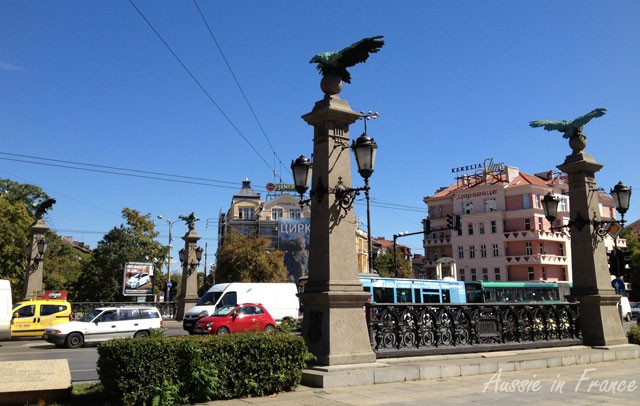
After lunch we go to Eagles’ Bridge (Orlov Most), spanning another tiny sliver of water – the Perlovska River. The bridge was built in 1891 by the same Czech architect as Lions’ Bridge. The four bronze eagles symbolise the citizens of Sofia returning from exile and being welcomed by their families. The bridge itself stands at an important crossroads in Sofia.
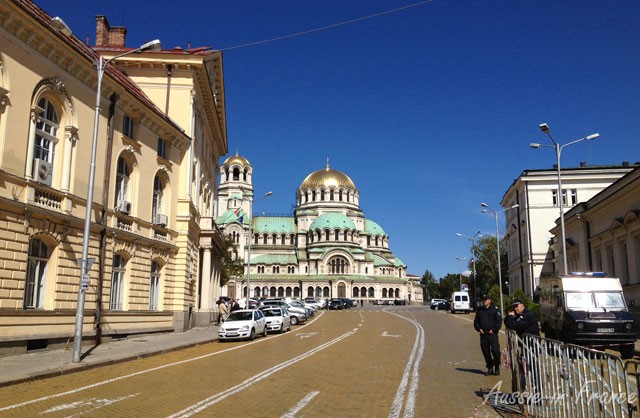
Our route then takes us past Nevski Cathedral which is completely cordoned off by police. Good thing we visited it yesterday. We have no idea what’s going on of course. Then we see a cavalcade of motorbikes approaching from the other direction. They don’t even take the street that’s been blocked off. Ah, if only we could communicate.

We reach the National Art Gallery, which also contains the Ethnographic museum that I’m very keen to visit. The lady at the ticket office asks if we’re seniors and gives us cheap tickets (3 lev each). This is the first time I’ve been given a reduction for being a senior. Not sure how I feel …
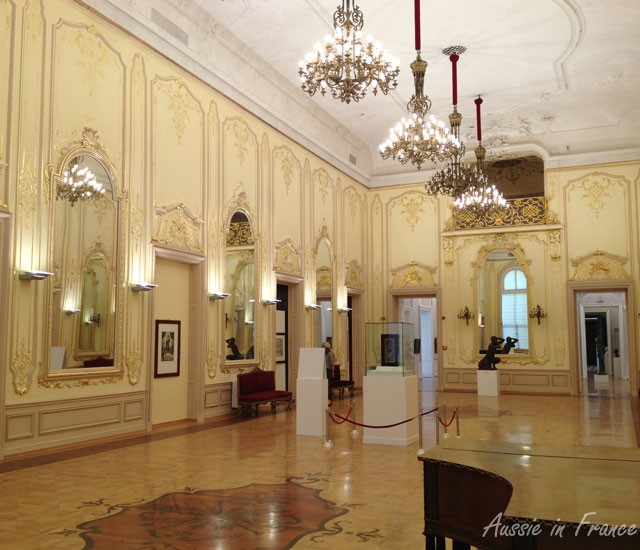
I’m disappointed to discover the Ethnographic Museum is closed for renovation but some of the rooms, particularly the ballroom, are well worth the visit.
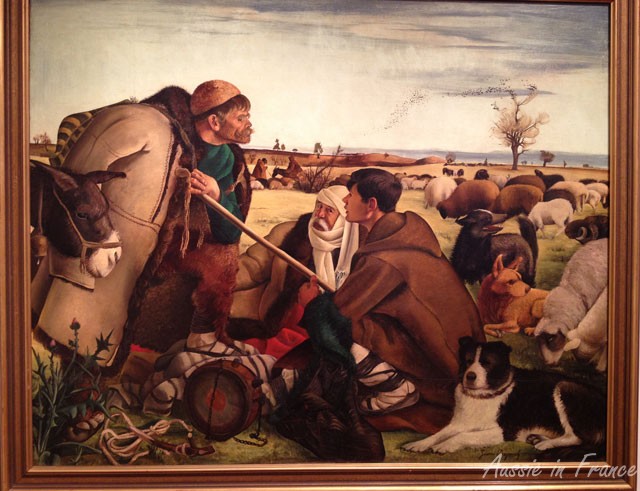
I also enjoy some of the more traditional 19th and 20th century Bulgarian artists, especially Vladimir Rilski, Vassil Stoilov and Zlatyu Boyadzhiev with their wonderful depiction of Hungarian rural life.
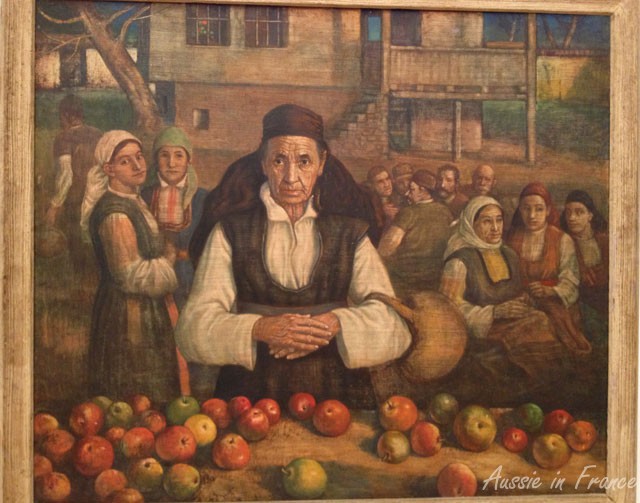
We walk back to our home exchange apartment and don’t seem to notice the poverty as much. I guess we’re getting used to it! Sofia seems to be one of those places that grows on you.
If you have enjoyed reading this, don’t forget to subscribe to new posts using the subscription form on the top right – that way you’ll get them directly on your smart phone or in your mail box! And I love to hear your comments!